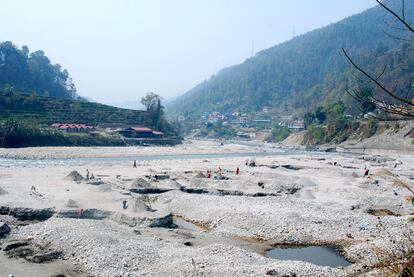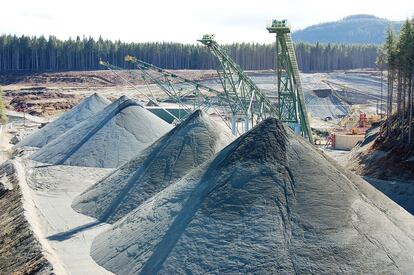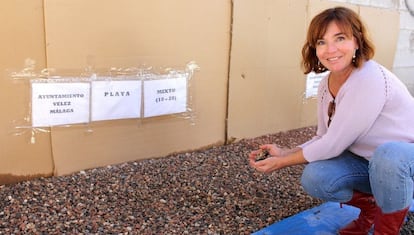Climate crisis: the shifting sands supporting human civilization
The rate at which we are extracting gravel for construction is 23 times greater than it was in 1900, and a lot of it is being done illegally. Experts warn about irreversible environmental and social impacts

In 2020, the global human-made mass outweighed the Earth’s living biomass for the first time. And most of it was made from gravel and sand. The extraction of these materials is 23 times greater today than in 1900 and the Organization for Economic Co-operation and Development (OECD) estimates that demand will double in the next 30 years. Many believe there is no planet that can withstand such plundering.
After water, sand is the natural material that is most widely extracted by humans. According to a recent study on the use of this solid material, gravel is extracted 10 times more than wood and about 20 times more than oil – a rough estimate, as most countries don’t keep records. There are, however, reliable statistics on cement production. Given that approximately 100 kilos of concrete require 1.5 kilos of air, 10 kilos of cement, 18.5 kilos of water, another 25 kilos of fine aggregates (sand) and another 45 kilos of coarse aggregates (gravel), we can estimate the total amount of aggregates used in construction.
According to a 2019 United Nations Environment Program (UNEP) report, the cement production recorded by 150 countries exceeded 4.1 billion tons in 2017. That implies that the aggregates needed to make concrete ranged from 28.7 to 32.8 billion tons that year. Added to that is the sand used in the glass industry and the gravel used in asphalt for roads. Meanwhile, there is little information about the relatively new phenomenon (except in the Netherlands) of land reclamation, sometimes by taking sand right out of the sea.
Desert sand is too soft and rounded to bind into concrete
In Southeast Asia, Singapore has increased its territory by 23% at the expense of the sea in the last few decades, according to the same UNEP report. To achieve this, it has imported 517 million tons of sand in the last 20 years. Much of that sand came from the Mekong River delta, which is becoming landlocked.
Singapore is not alone. For years, Dubai and Saudi Arabia have been importing sand from Australia, on the other side of the Indian Ocean. The desert sand which is abundant on the Arabian Peninsula is not suitable for building houses: wind erosion has rounded and softened it to the extent that there are no edges left to bind it into cement. The buildings would crumble like sugar cubes.
With desert sand out of the equation, there are three main sources of sand left: beaches, riverside areas and quarries, where sand is obtained by pulverizing the rock. All come at a cost. Sand mining off the coast of Sri Lanka exacerbated the impact of the 2004 tsunami, which killed more than 35,000 people. The paradox is that to repair the damage to the coastline caused by the tsunami, many tons of new sand were extracted from Sri Lanka’s rivers.
Indian environmental researcher Kiran Pereira describes the plight of Sri Lanka’s beach and river sands in her book, Sand Stories. “Removal of sand dunes and extensive illegal dredging increased flooding,” says Pereira. “The removal of sand from rivers lowered river beds, increasing bank erosion. It also drastically reduced the sediment supplied to the coast. Continued sand mining of rivers, beaches and dunes reduced the sand needed to replenish what was lost during the storm, but, ironically, an additional 10 million cubic meters were needed for restoration and rehabilitation. Sand dunes, beaches and other natural ecosystems such as wetlands and mangroves have a critical role to play as buffers against storm force. We destroy them at our peril.”

An added problem is that much of this sand is being illegally extracted without any kind of oversight. A study carried out by the conservationist organization World Wildlife Fund (WWF) puts the number of countries where sand and gravel extraction is out of control at 70. Aside from a few marginal cases, illegal exploitation no longer occurs in the most developed countries; not even in China, where, as in the West, they are turning to quarrying and crushing the rock instead.
The ecologist Aurora Torres recognizes that most of the problems today are in “fast-growing economies with weak resource governance.” Torres coordinates the European-funded Sandlinks project, carried out by the Catholic University of Leuven in Belgium and Michigan State University in the United States. According to Torres, “in these countries, the first option is to go for the most accessible resources from rivers and coastal areas, which is where there may be a greater impact if they are not extracted correctly.”
Although the developed world now only crushes rock in quarries, making the impact more local, it still practices sand mining, albeit by importing it. As a Los Angeles Times article explained back in 2017, LA’s new projects are being made with sand brought in from Vancouver in Canada, 2,250 kilometers away.
“We are not running out of sand,” says Torres. “But there is an economic shortfall due to environmental factors, competition with food production and the protection of nature.” There are also several indicators that things are going to get worse. On the one hand, two parallel demographic phenomena are occurring, especially in fast-growing economies such as China and India, the two most highly populated countries in the world. One is simple population growth, which means more urbanization, that is to say, more houses. The other is that the surface area of homes per capita is increasing, as people seek larger houses.
Two parallel phenomena are occurring. One is population growth, which means more houses. The other is that the surface area of homes per capita is increasing
According to the OECD report, the demand for gravel and sand will increase from 24 gigatons (each gigaton being equivalent to 1 billion metric tons) to 55 gigatons by 2060. There is also a new factor that is of great concern to scientists and which has not been entirely factored in when calculating future demand for sand: climate change.
The geologist Mette Bendixen, from McGill University in Canada, explains part of the impact that climate change will have on the sand crisis. “As the climate changes, sea levels will rise and the need to protect coastal areas will increase,” she says. In other words, the recovery of beaches will require extra sand input. “Another implication is that as temperatures rise, the stress on the planet’s infrastructure, such as roads, will be exacerbated and these are made with sand and gravel,” she adds. In turn, the consequent need for more aggregates will put more pressure on the environment.
As author of a key study on the issue published in 2017 in the journal Science, Torres warns that there are many elements to consider. “Knowing the available resources, reducing demand, reusing waste,” she says. One example of reusing waste is Brick-Beach, a project launched in the south of Spain, in the town of Vélez-Málaga. Following the building of a port in the 1970s, Mezquitilla beach disappeared. Now a project is underway to recover it with concrete and bricks sifted from the rubble left over from local demolition and construction work.

Financed with European funds, the initiative is coordinated by the city’s chief of strategic projects, Pablo Fernández. “The idea is to recover the debris from illegal dumps left by the construction boom and recover the beach,” he says. It sounds simple, but is, in fact, somewhat complicated. A plant is required (which will shortly go out to tender) to sift through the debris so that only the concrete and clay from the bricks remain. Afterwards, a kind of mill will grind and separate the cement and gypsum, leaving pebbles that are “very pleasant to walk on,” according to Fernández.
Brick-Beach has brought together public administrations, the University of Málaga, environmental organizations and even the private sector. Pablo Pérez heads the Association of Construction and Demolition Waste Management Companies of Andalusia (Agreca), which is also participating in the project. “The annual demand for aggregates in Spain is 2,500 kilograms per inhabitant,” he says. About 1,000 kilograms per inhabitant are recovered, of which 700 can be recycled. “That’s 28% of all demand,” he points out. Recycled aggregates are already being used in road surfacing, under sidewalks and for cycle paths. Now, as Pérez says, “they could also be returned to the beaches.”
English version by Heather Galloway.
Tu suscripción se está usando en otro dispositivo
¿Quieres añadir otro usuario a tu suscripción?
Si continúas leyendo en este dispositivo, no se podrá leer en el otro.
FlechaTu suscripción se está usando en otro dispositivo y solo puedes acceder a EL PAÍS desde un dispositivo a la vez.
Si quieres compartir tu cuenta, cambia tu suscripción a la modalidad Premium, así podrás añadir otro usuario. Cada uno accederá con su propia cuenta de email, lo que os permitirá personalizar vuestra experiencia en EL PAÍS.
¿Tienes una suscripción de empresa? Accede aquí para contratar más cuentas.
En el caso de no saber quién está usando tu cuenta, te recomendamos cambiar tu contraseña aquí.
Si decides continuar compartiendo tu cuenta, este mensaje se mostrará en tu dispositivo y en el de la otra persona que está usando tu cuenta de forma indefinida, afectando a tu experiencia de lectura. Puedes consultar aquí los términos y condiciones de la suscripción digital.











































